#9th century
Text
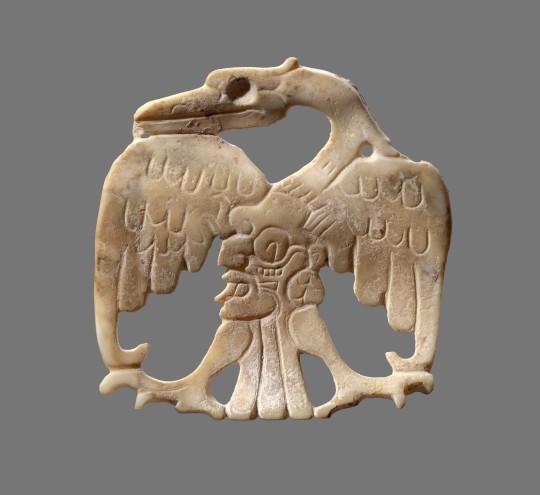
~ Bird ornament.
Date: A.D. 600–800
Place of origin: Guatemala or Mexico, Mesoamerica
Culture: Maya
Medium: Shell
#history#museum#archeology#archaeology#Mesoamerica#precolumbian#bird ornament#guatemala#mexico#7th century#9th century#shell#maya#a.d. 600#a.d. 800
1K notes
·
View notes
Photo



Love's Messenger (details) by Marie Spartali Stillman (1844 - 1927)
#artedit#art history#painting detail#art detail#painting#painting details#art details#marie spartali stillman#9th century#xix century#art#mine
2K notes
·
View notes
Text


the 12 months and their corresponding peasant work (+ close-up of december)
in an encyclopedic miscellany ("liber calculationis"), salzburg, c. 818 AD
source: Munich, BSB, Clm 210, fol. 91v
#this is OLD old#love december's hand btw#9th century#medieval art#medieval manuscript#months#peasants#medieval labour
474 notes
·
View notes
Text
"That Æthelswith was the bestower of such gifts is consistent with the other things we know about her. In 868 she witnessed a West-Saxon charter, in which she made a grant of fifteen hides of her own land in Berkshire. She also witnessed all of her husband King Burgred’s charters. Though we only see glimpses of her influence, Æthelswith, like other Mercian queens before her, was a politician.
In 874, twenty one years after Æthelswith married Burgred, the royal couple were forced out of their kingdom by an encroaching Viking army. They fled together to safety in Rome. While Burgred died soon after they arrived, Æthelswith outlived him for another decade, which she spent in Italy.
Queen Æthelswith passed away in 888 in Pavia, and was laid to rest there. She may have been undertaking a pilgrimage when she died. Her body and the ring that she once bestowed were both buried underground a thousand miles apart. And they say medieval women didn’t travel…"
#Æthelswith#history#women in history#women's history#9th century#english history#queens#leaders#english queens#anglo saxon history#anglo saxon england#medieval women#medieval history#middle ages#medieval#archeology
249 notes
·
View notes
Photo

The "world" in the eyes of 9th century Abbasids
151 notes
·
View notes
Photo

The Gokstad ship is a 9th-century Viking ship found in a burial mound at Gokstad in Sandar, Sandefjord, Vestfold, Norway.
838 notes
·
View notes
Text

Hildegard von Bingen !!!!!!!!!!!!!!!!!!!!!!!!!!!!!!!
she was a nun and a scientist and a musician and poet and invented her own language and alphabet. which i think is pretty neat.
this drawing is based on a specific medieval illustration: (link)
#medieval#hildegard von bingen#history#medieval art#manuscript#middle ages#music#music history#lingua ignota#medievalcore#medieval europe#9th century#women in history#art#illustration
260 notes
·
View notes
Text


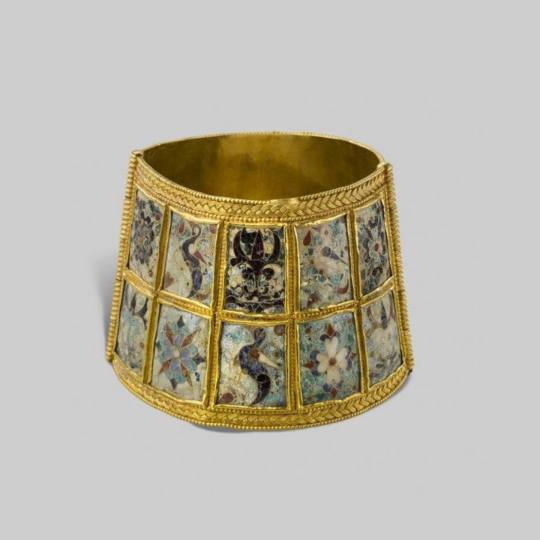
Gold bracelets dated 9th–10th centur, Constantinople, Turkey.
Each bracelet consists of twenty partitions that are framed by granular strips and are decorated with cloisonné enamel.
The partitions alternately depict birds pecking at leaves, palms and rosettes and are rendered in different colour variations.
Museum of Byzantine Culture, Thessaloniki
#art#history#design#style#archeology#sculpture#gold#bracelet#jewelry#jewellery#turkey#constantinople#9th century#10th century#cloisonné#enamel#birds#leaves#palms#rosettes#byzantine
149 notes
·
View notes
Text

Silver Coin from Winchester, England dated between 875 - 885 on display at Winchester Catherdral, England
This coin was excavated in the Cathedral Close and bears the head of Alfred the Great with the inscription +ÆLFREDREXSA+ which translates to Alfred, King of the Saxons. From 871 to 886 Alfred was King of the West Saxons, the Kingdom of Wessex. During this time of Alfred's reign the Vikings under Guthrum, later King of East Anglia (879 - 890?), Ivar the Boneless, Halfdan Ragnarson, Ubba and Bagsecg formed the Great Heathen Army and invaded much of England.
Photographs taken by myself 2023
#art#archaeology#history#england#english#medieval#9th century#winchester cathedral#museum#winchester#barbucomedie
115 notes
·
View notes
Text

Feeling blue?
1000 years before the blue elephant emoji was added to phones, some Italian monks drew this elephant and friends in a manuscript for Abbot Theobald of Monte Cassino. Monte Cassino was an important monastery and home to St Benedict whose rule is the basis for the Benedictine Order of monks and nuns that still exists today.
This manuscript contains an abbreviation of Hrabanus Maurus's De Rerum Naturis (On the Natures of Things). Hrabanus Maurus (d. 856) was archbishop of Mainz. In addition to encyclodpedia-like works sucha as De Rerum Naturis, he wrote Biblical commentaries, grammars, teaching texts and poems with complex palindromes. He wrote so much that his surviving writings fill about 6 modern type-set volumes.
Materials: parchment, pigments, ink
Contents: Hrabanus Maurus, De Rerum Naturis
Date: 1022-1032
Now Archivio dell'Abbazia, Montecassino, MS 132 (image from a facsimile)
61 notes
·
View notes
Text

LORSCH GOSPELS. This ivory book cover illustrates late imperial scenes adapted to a Christian theme. It is a striking example of early 9th Century Carolingian art. The front panels are in the collection of the Victoria and Albert Museum.
The manuscript, written in Latin between 778 and 820, roughly coincides with the period of Charlemagne's rule over the Frankish Empire.
The attempt in Northern Europe to revive and emulate classical Mediterranean art forms and styles resulted in a blending of classical and Northern elements in a sumptuous and dignified style. The Northern confidence representing the human figure set the stage for the rise of Romanesque art and eventually Gothic art in the West. The Carolingian era is part of the period in medieval art sometimes called the "Pre-Romanesque". After a rather chaotic interval following the Carolingian period, the new Ottonian dynasty revived Imperial art from about 950, building on and further developing Carolingian style in Ottonian art.
source
#beautiful books#book blog#books books books#book cover#books#incunabula#gospel#christian bible#carolingian#9th century#ivory#charlemagne#frankish
60 notes
·
View notes
Text




~ Cylinder Vessel with Palace Scene.
Place of origin: Guatemala, Petén, Dos Pilas or vicinity
Culture: Maya, lk style
Date: A.D. 740–800
Medium: Slip-painted ceramic with post-fire pigment.
#8th century#9th century#cylinder vessel#ceramics#palace scene#petén#dos pilas#guatemala#ik style#maya#mayan#pigment#Mesoamerica#pre columbian#a.d. 740#a.d. 800#history#museum#archeology#archaeology
265 notes
·
View notes
Text
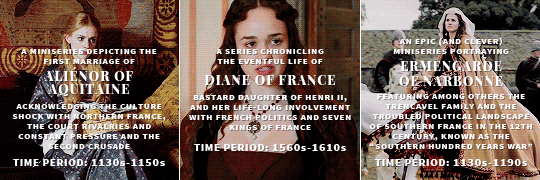
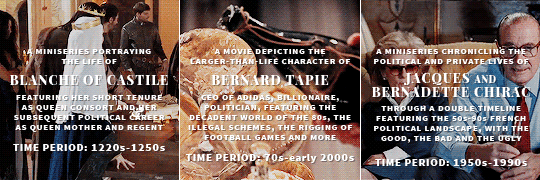
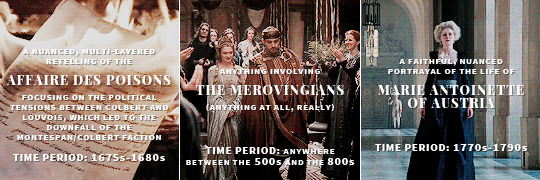
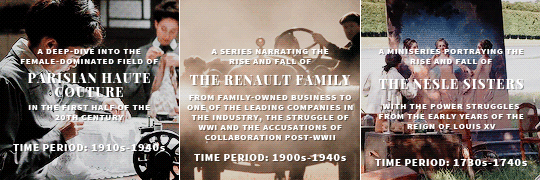

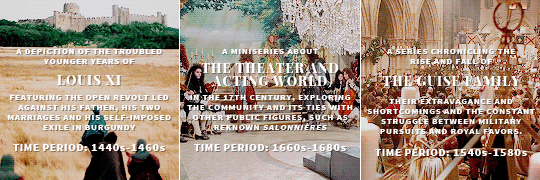

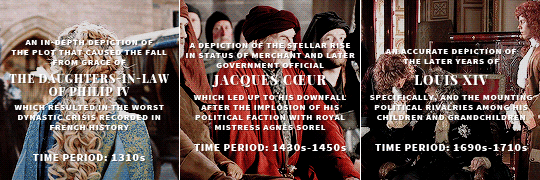

(some) of the period dramas i'd love to see about french history
#historyedit#perioddramaedit#14th century#13th century#12th century#9th century#6th century#19th century#20th century#15th century#16th century#17th century#18th century#mine#*
384 notes
·
View notes
Text

an anthropomorphic mandrake being dug up with the help of a dog tied to its feet/roots
in "pseudo-antonius musa: de herba betonica", latin manuscript, late 9th century
source: Kassel, UB, 2° Ms. phys. et hist. nat. 10, fol. 34v
#this is a very typical depiction of the mandrake#mandrake#mandrake root#alraune#9th century#medieval#medieval art#medieval myths#herbarium#dog#plant#illuminated manuscript
607 notes
·
View notes
Text

Bodhisattva Cintāmaṇicakra, 9-10th century
Heian period, Japan
Wood, single block construction
Height: 94.9
Important Cultural Property
The legend said that this statue was discovered in the sea of Tango region. The carving technique of the early Heian period can be seen on the stern face with connected eyebrows, as well as the thick and broad body structure. The scarf-like cloth (jōhaku) was draped widely which is rare to see, it leads a theory that this statue belongs to the Tendai sect.
Collection of the Nara National Museum
#Avalokitesvara#Buddhism#bodhisattva#figure#religion#kannon#Japanese#觀音#cintamanicakra#cintamani#sculpture#wood#carving#9th century#10th century#art#art history#Nara National Museum#iconography#gesture#Heian period#symbolism
290 notes
·
View notes
Photo
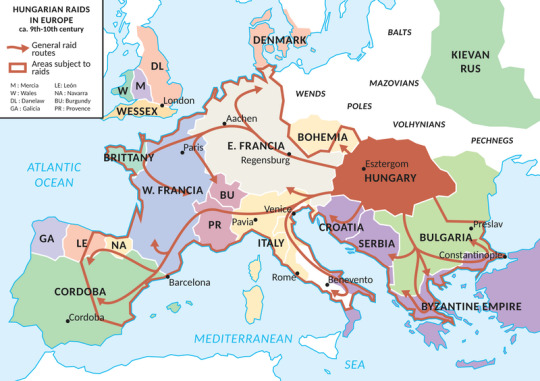
Hungarian raids in Europe, 9th-10th century.
139 notes
·
View notes